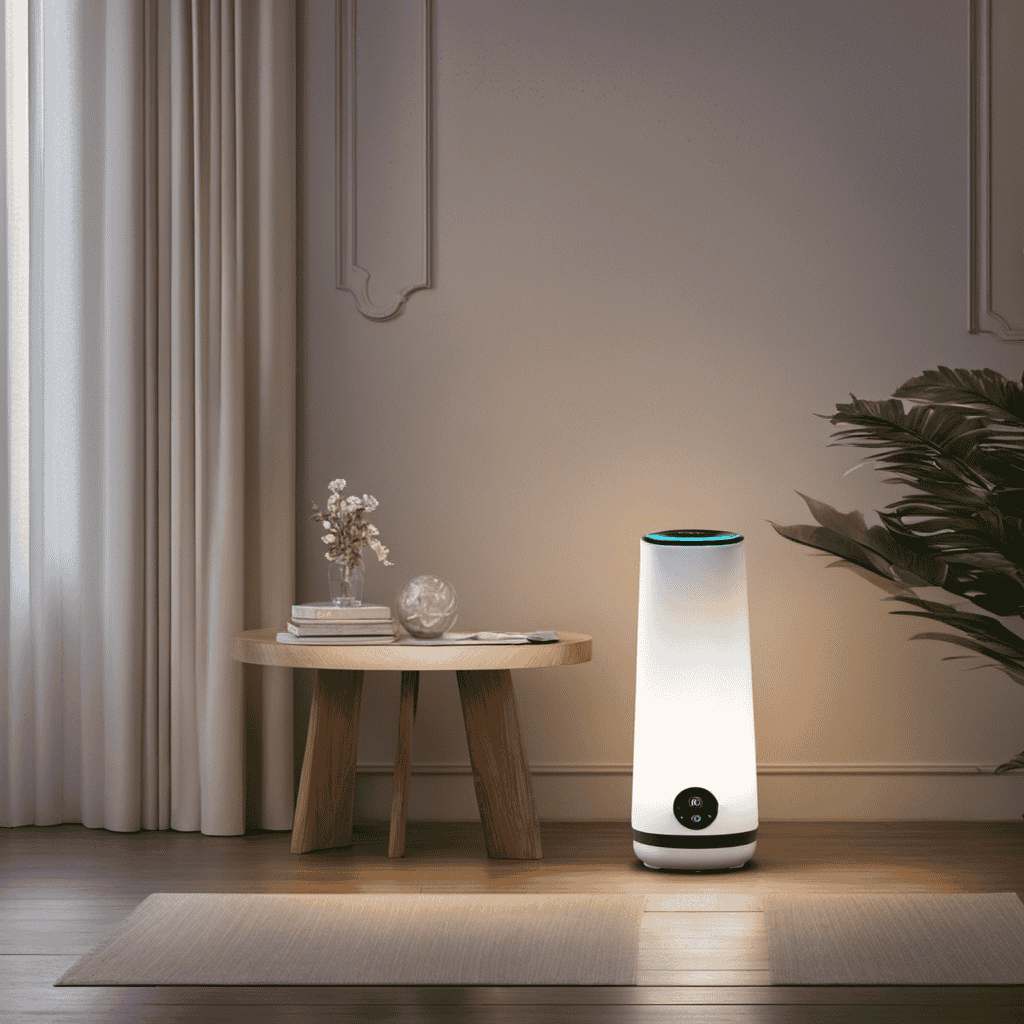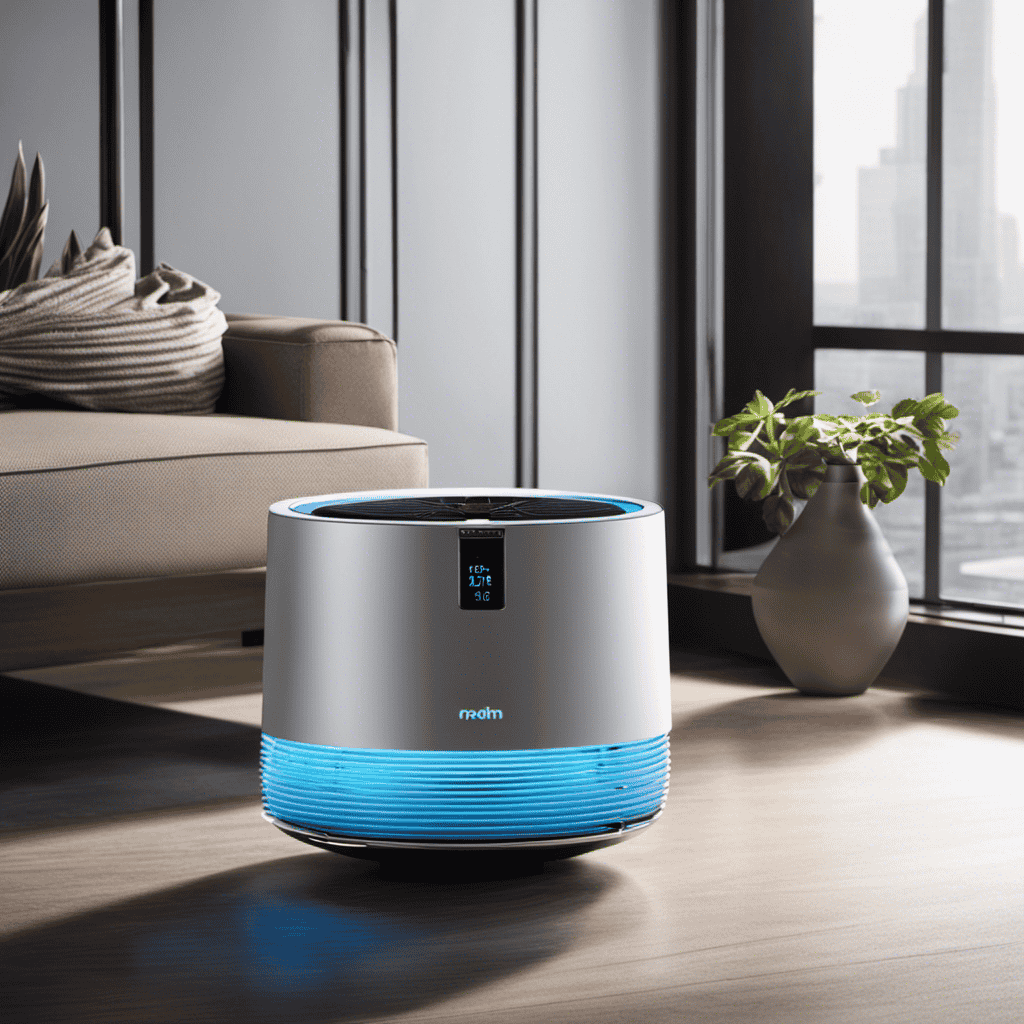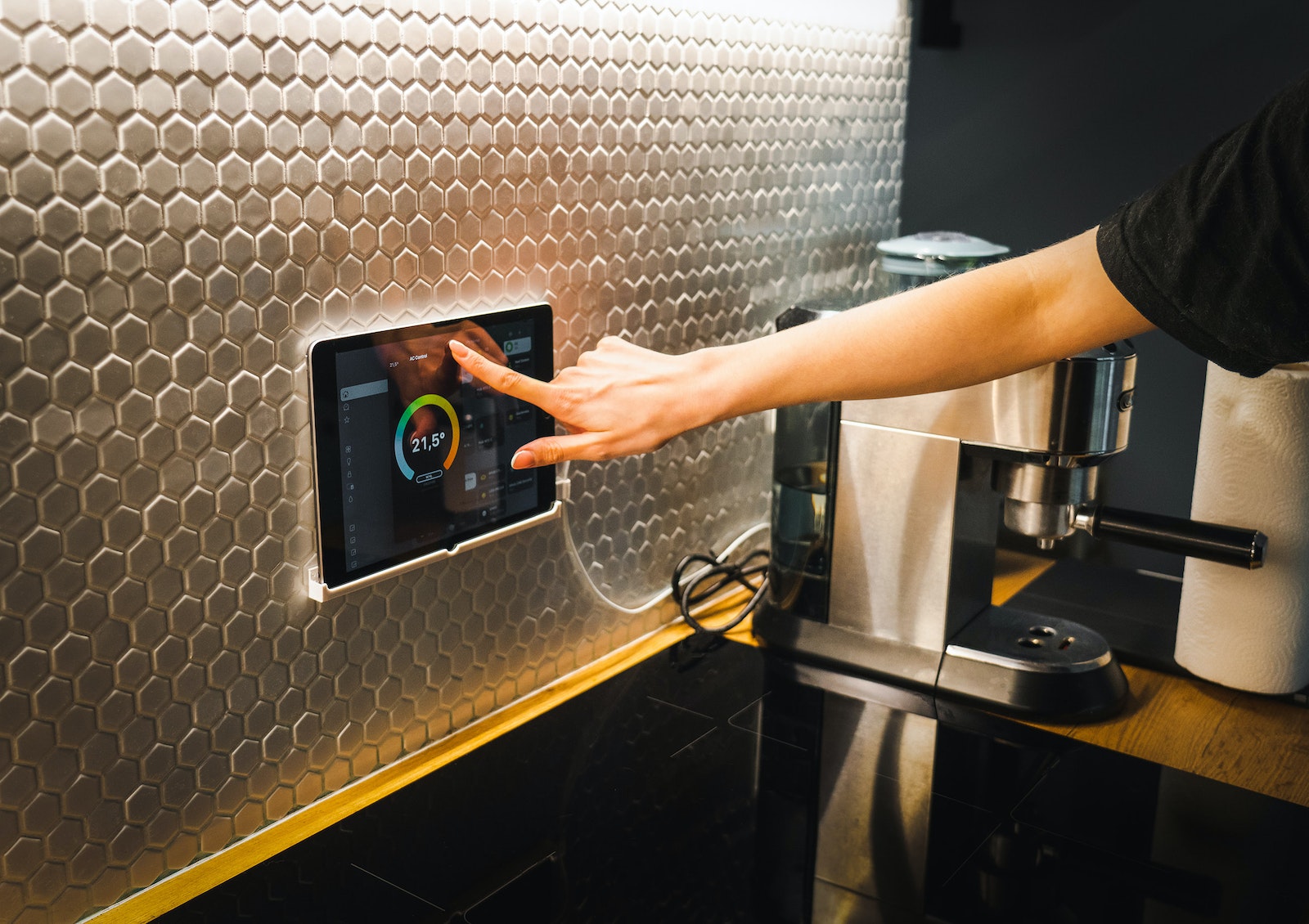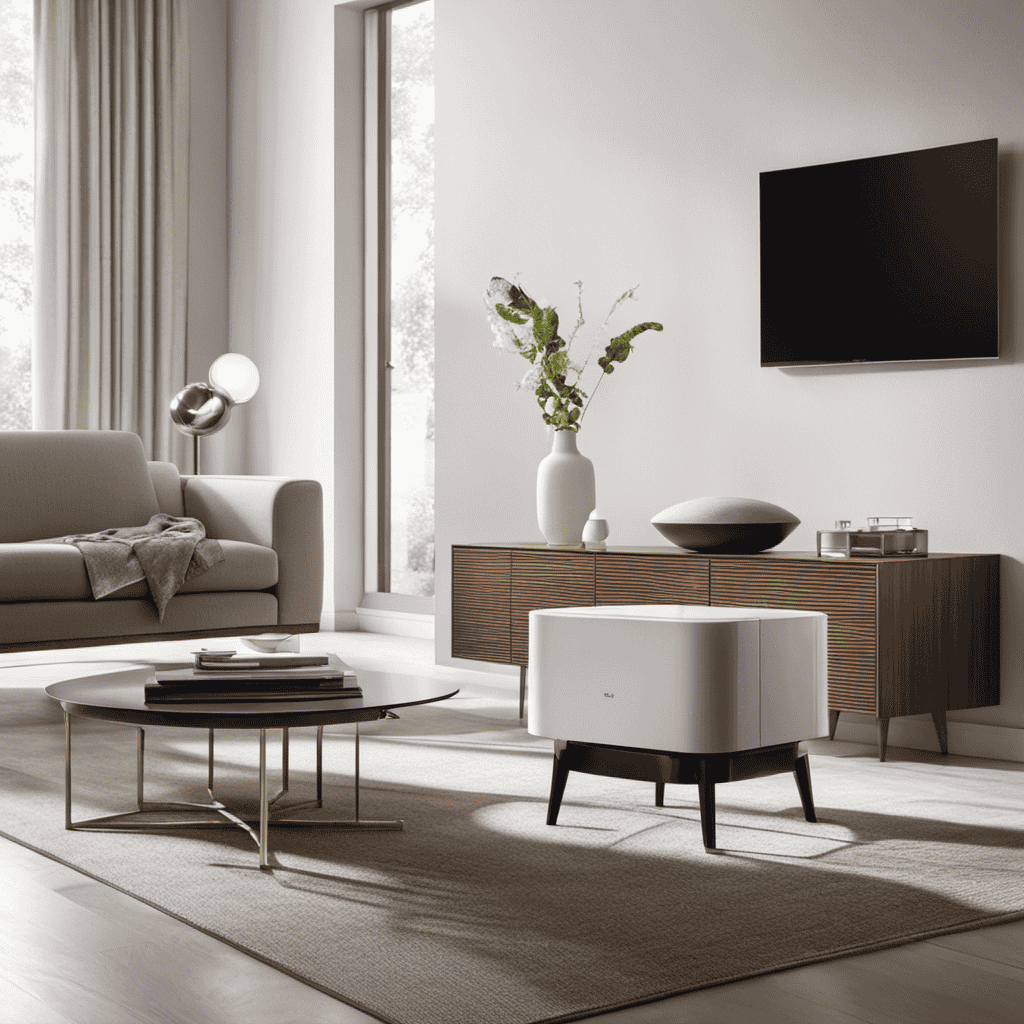As an individual who has faced challenges with allergies and dry indoor air, I recognize the significance of discovering the appropriate solution.
The battle between an air purifier and a humidifier can be overwhelming, but fear not! In this article, we will dive deep into the benefits of each device, factors to consider when choosing, and tips for maintenance.
So, buckle up and get ready for a thorough exploration of whether an air purifier or a humidifier is the better option for improving your indoor air quality.
Key Takeaways
- Air purifiers remove pollutants and allergens from the air, improving respiratory health and creating a cleaner environment.
- Humidifiers add moisture to dry air, alleviating dryness in the air, reducing respiratory discomfort, and keeping skin hydrated.
- Air purifiers are suitable for allergies or asthma, while humidifiers benefit dry skin and respiratory issues caused by dry air.
- Air purifiers require filter replacements and cleaning, while humidifiers need regular cleaning and occasional tank replacement.
Benefits of an Air Purifier
If you suffer from allergies or asthma, an air purifier can greatly improve your indoor air quality. The benefits of clean air cannot be overstated when it comes to improving respiratory health.
Air purifiers work by filtering out pollutants, such as dust, pollen, pet dander, and mold spores, from the air, which can trigger allergy or asthma symptoms. By removing these irritants, air purifiers create a cleaner and healthier environment, reducing the risk of respiratory flare-ups and promoting better breathing.
Studies have shown that using air purifiers can lead to a decrease in symptoms and medication use for individuals with allergies or asthma. With cleaner air to breathe, you can enjoy improved respiratory health and a higher quality of life.
Now, let’s explore the advantages of a humidifier.
Advantages of a Humidifier
The advantages of a humidifier include reducing dryness in the air and improving respiratory health. Here are some reasons why a humidifier can be beneficial:
-
Humidifier benefits for sleep:
-
Adequate humidity levels can help alleviate snoring and nasal congestion, promoting better sleep.
-
Moist air can prevent dry throat and skin, enabling a more comfortable sleep environment.
-
Improving indoor air quality with a humidifier:
-
By maintaining optimal humidity levels, a humidifier can reduce the transmission of respiratory viruses and bacteria.
-
Adding moisture to the air can alleviate symptoms of allergies and asthma, as dry air can exacerbate these conditions.
Using a humidifier can greatly enhance sleep quality and create a healthier indoor environment. However, it is essential to consider various factors when choosing between an air purifier and a humidifier.
Factors to Consider When Choosing Between an Air Purifier and a Humidifier
When choosing between an air purifier and a humidifier, you should consider factors such as your specific needs and the current air quality in your home. Both devices have their own benefits and can improve the overall air quality, but understanding your requirements is crucial.
| Factors to Consider | Air Purifier | Humidifier |
|---|---|---|
| Air Quality | Ideal for removing allergens, pollutants, and odors from the air. | Helps add moisture to dry air, improving respiratory health and preventing dry skin. |
| Specific Needs | Suitable for those with allergies or asthma, as it filters out particles and improves indoor air quality. | Recommended for individuals with dry skin, sinus congestion, or respiratory issues caused by dry air. |
| Maintenance | Requires regular filter replacements and cleaning. | Requires regular cleaning and occasional maintenance, such as replacing the water tank. |
| Cost | Initial cost can be higher, but it can save on long-term health expenses. | Generally more affordable, but costs can add up over time due to maintenance and water consumption. |
Considering these factors can help you make an informed decision based on your specific needs and the health benefits each device provides.
Improving Indoor Air Quality With an Air Purifier
To improve the air quality in your home, you should consider using an air purifier. Air purifiers are effective at reducing allergens in the air, which can help alleviate symptoms for those suffering from allergies or asthma.
Here are some reasons why using an air purifier can be beneficial:
-
Improved Sleep Quality:
Air purifiers can help remove airborne particles that may disrupt sleep, such as dust and pollen. Cleaner air can lead to a more peaceful and restful sleep, allowing you to wake up feeling refreshed. -
Reduced Allergens in the Air:
Air purifiers can capture and eliminate common allergens like pet dander, mold spores, and pollen. Removing these allergens from the air can significantly reduce allergy symptoms and promote overall respiratory health.
Investing in an air purifier can make a noticeable difference in the quality of the air you breathe, ultimately improving your sleep and reducing allergens in your home.
How a Humidifier Can Help With Dry Air Issues
As someone who has experienced the effects of dry indoor air, I can attest to the benefits of using a humidifier.
Not only does it moisturize the air, providing much-needed relief for dry sinuses and throat, but it also helps alleviate respiratory discomfort.
Additionally, a humidifier can prevent dry skin, keeping it hydrated and radiant.
Moisturizes Dry Indoor Air
Using a humidifier can help moisturize dry indoor air, making it more comfortable to breathe. Dry air can cause a range of issues, including dry skin, irritated nasal passages, and even respiratory problems. By adding moisture to the air, a humidifier can alleviate these symptoms and improve air quality in your home.
Here are some benefits of using a humidifier:
-
Improved air quality:
Humidifiers can help reduce the amount of dust and airborne allergens in the air, making it easier to breathe and preventing allergies. They can also help alleviate symptoms of asthma and other respiratory conditions by keeping the air moist and reducing irritation. -
Preventing allergies:
By maintaining optimal humidity levels, humidifiers can prevent the growth of mold and mildew, which are common allergens. They can also soothe irritated nasal passages and reduce the frequency and severity of allergy symptoms.
Relieves Respiratory Discomfort
Adding moisture to the air with a humidifier can relieve respiratory discomfort caused by dryness. When the air in your home is too dry, it can irritate your nasal passages, throat, and lungs, leading to symptoms like coughing, wheezing, and congestion.
A humidifier helps to increase the humidity levels in the air, providing relief from these symptoms and reducing congestion. It works by releasing water vapor into the environment, which moistens the air and makes it easier to breathe. Humidifiers offer various relief options, such as adjustable humidity settings, warm or cool mist options, and the ability to add essential oils for further respiratory support.
By using a humidifier, you can create a more comfortable environment and alleviate respiratory discomfort caused by dryness.
Now, let’s move on to how a humidifier prevents dry skin.
Prevents Dry Skin
A humidifier helps prevent dry skin by increasing the moisture levels in the air, keeping your skin hydrated and reducing the occurrence of dryness and itching. It is a valuable tool for combating allergies as well.
Here are some benefits of using a humidifier:
-
Moisturizes the skin: By adding moisture to the air, a humidifier helps to hydrate your skin, preventing it from becoming dry and flaky.
-
Reduces allergy symptoms: Dry air can worsen allergy symptoms, such as congestion and irritated nasal passages. A humidifier helps to alleviate these symptoms by adding moisture to the air, reducing the irritation caused by allergens.
-
Promotes better sleep: Dry air can cause discomfort during sleep, leading to a restless night. A humidifier helps to create a more comfortable sleeping environment by keeping the air moist.
Understanding the Different Types of Air Purifiers
To better understand the different types of air purifiers, you’ll want to consider factors such as filtration methods and room size coverage.
There are several different types of air purifiers available on the market today, each with its own unique set of features and benefits.
One common type is the High-Efficiency Particulate Air (HEPA) filter purifier. These purifiers work by using a dense filter to trap and remove airborne particles, such as dust, pollen, and pet dander.
Another type is the activated carbon filter purifier, which uses a porous carbon material to absorb and neutralize odors and gases.
Additionally, there are ionizer purifiers that release negative ions into the air to attach to and remove pollutants.
It’s important to choose the right type of purifier for your specific needs and to understand how they work to effectively clean the air in your home.
Exploring the Various Types of Humidifiers
I have researched the benefits of using a humidifier for health and the different types of humidifiers available.
Humidifiers can provide relief for dry skin, allergies, and respiratory issues by adding moisture to the air.
There are several types of humidifiers to choose from, including evaporative, ultrasonic, and steam humidifiers, each with its own advantages and considerations.
Humidifier Benefits for Health
You’ll notice that using a humidifier regularly can have various benefits for your health. Here are some reasons why a humidifier can be beneficial for allergies and sinus congestion:
-
Humidifier for Allergies:
-
Helps to relieve dryness and irritation in the nasal passages, reducing the frequency of allergic reactions.
-
Maintains the optimal humidity level in the air, preventing the growth of mold and dust mites, which are common allergens.
-
Humidifier for Sinus Congestion:
-
Adds moisture to the air, helping to thin the mucus and relieve sinus congestion.
-
Soothes inflamed nasal tissues, reducing discomfort and promoting easier breathing.
Studies have shown that using a humidifier can improve symptoms related to allergies and sinus congestion. However, it’s important to maintain proper cleaning and maintenance to prevent the growth of bacteria or mold in the humidifier. Always consult with a healthcare professional for personalized advice and recommendations.
Types of Humidifiers Available
If you’re considering purchasing a humidifier, it’s important to be aware of the different types available.
There are several types of humidifiers on the market, each with their own unique features and benefits. The most common types include evaporative humidifiers, ultrasonic humidifiers, and steam vaporizers.
Evaporative humidifiers work by using a fan to blow air through a moistened wick, releasing moisture into the air. Ultrasonic humidifiers use ultrasonic vibrations to create a fine mist of water particles, while steam vaporizers heat water to create steam that is released into the air.
The benefits of using a humidifier include relieving dry skin and nasal passages, reducing symptoms of allergies and asthma, and preventing the spread of viruses and bacteria.
It’s important to choose the right type of humidifier for your specific needs to maximize the benefits.
Comparing the Cost of Air Purifiers and Humidifiers
Comparing the cost of air purifiers and humidifiers, it’s important to consider long-term expenses. When it comes to cost comparison, air purifiers tend to be more expensive upfront than humidifiers. However, it’s crucial to look beyond the initial price tag and consider the long-term benefits and drawbacks of each option.
Here are some key points to consider:
-
Air purifiers:
-
Initial cost: Higher upfront investment.
-
Energy efficiency: Many models are designed to be energy-efficient, reducing long-term operating costs.
-
Maintenance: Filters need to be replaced periodically, adding to the overall cost.
-
Health benefits: Effective at removing allergens, pollutants, and improving indoor air quality.
-
Humidifiers:
-
Initial cost: Generally less expensive than air purifiers.
-
Energy efficiency: Some humidifiers may consume more electricity, leading to higher operating costs.
-
Maintenance: Regular cleaning and occasional replacement of parts are necessary.
-
Health benefits: Helps alleviate dryness, congestion, and improves respiratory health.
Considering the cost comparison and energy efficiency, it’s essential to weigh the long-term expenses and choose the option that best suits your needs and budget.
Maintenance and Care Tips for Air Purifiers
To keep your air purifier running efficiently, it’s important to regularly clean and replace the filters. Maintaining filters is crucial because they play a vital role in trapping pollutants and allergens, ensuring that the air you breathe is clean and healthy.
Cleaning techniques vary depending on the type of filter. For pre-filters, gently vacuuming or rinsing with water can effectively remove larger particles. HEPA filters, on the other hand, should be replaced every 6 to 12 months, as they lose their effectiveness over time. Carbon filters typically last for about 6 months before needing replacement.
It’s also essential to follow the manufacturer’s instructions for proper maintenance. By regularly cleaning and replacing filters, you can prolong the lifespan of your air purifier and maintain its optimal performance, providing you with cleaner and fresher air.
Tips for Maintaining and Cleaning a Humidifier
When it comes to maintaining and cleaning a humidifier, two key points to focus on are preventing mold and bacteria growth, and proper water tank maintenance.
Mold and bacteria can thrive in a humid environment, so it’s crucial to take steps to prevent their growth. This includes regularly cleaning and disinfecting the humidifier, using distilled water, and replacing filters as recommended by the manufacturer.
Additionally, proper water tank maintenance is essential to ensure the efficient and safe operation of the humidifier. This involves emptying and drying the tank daily, avoiding overfilling, and regularly inspecting for any signs of damage or leakage.
Preventing Mold and Bacteria
To prevent mold and bacteria, you’ll want to regularly clean and maintain both your air purifier and humidifier. These devices are designed to improve indoor air quality, but if not properly cared for, they can become breeding grounds for harmful microorganisms.
Here are some tips to keep them clean and prevent respiratory infections and allergies:
-
Air Purifier:
-
Clean or replace the filters regularly to ensure optimal performance and prevent the buildup of mold and bacteria.
-
Wipe down the exterior of the purifier with a damp cloth to remove dust and dirt.
-
Humidifier:
-
Empty and refill the water tank daily to prevent the growth of mold and bacteria.
-
Clean the humidifier using a mixture of white vinegar and water every week to remove mineral deposits and disinfect the unit.
Proper Water Tank Maintenance
Now that we’ve discussed the importance of preventing mold and bacteria growth in air purifiers and humidifiers, let’s delve into the topic of proper water tank maintenance.
Regular water tank cleaning is essential to prevent the growth of harmful bacteria and ensure the optimal performance of your device.
To start, it’s crucial to follow the manufacturer’s instructions for cleaning and maintenance. This may include regular emptying, scrubbing, and disinfecting of the water tank. Additionally, it’s recommended to use distilled or demineralized water to minimize mineral buildup and bacterial growth.
Cleaning the water tank not only prevents the growth of bacteria but also helps to maintain the efficiency of your device. Bacteria can accumulate in stagnant water, leading to foul odors and potentially releasing harmful particles into the air.
Choosing the Right Device for Your Home: Air Purifier or Humidifier?
Deciding between an air purifier or a humidifier for your home can be challenging, but it’s important to choose the right device for your specific needs. Factors to consider when making this decision include your personal health needs, the climate in your area, and the current air quality in your home.
Benefits of using an air purifier:
- Removes harmful pollutants from the air, such as dust, pet dander, and pollen.
- Improves indoor air quality, reducing the risk of respiratory issues and allergies.
Benefits of using a humidifier:
- Adds moisture to the air, preventing dryness and keeping your skin and respiratory system hydrated.
- Relieves symptoms of dry skin, dry throat, and dry eyes.
When deciding between an air purifier or a humidifier, it’s important to evaluate your specific needs and choose the device that will provide the most benefits for you and your home.
Frequently Asked Questions
Can an Air Purifier Also Act as a Humidifier?
An air purifier and a humidifier serve different purposes. While an air purifier helps remove pollutants and allergens from the air, a humidifier adds moisture to combat dryness. They both have their own unique benefits.
Which Is More Effective in Reducing Allergies: an Air Purifier or a Humidifier?
When it comes to respiratory health, the effectiveness of air purifiers and humidifiers in reducing indoor pollutants differs. Air purifiers target allergens, while humidifiers add moisture to the air. Both can contribute to better air quality, depending on specific needs.
Are There Any Health Risks Associated With Using an Air Purifier or a Humidifier?
When it comes to potential side effects and long-term effects, both air purifiers and humidifiers have their own considerations. It’s important to understand the specific risks associated with each and make an informed decision based on your individual needs.
Can an Air Purifier or a Humidifier Eliminate Pet Odors in the Home?
An air purifier and a humidifier serve different purposes. An air purifier can eliminate pet odors by filtering out particles in the air, while a humidifier can add moisture to the air, which may help reduce odors.
How Do Air Purifiers and Humidifiers Affect Energy Consumption in the Home?
I can discuss the environmental impact of air purifiers and humidifiers, as well as the cost effectiveness of using them in the long run. Let’s dive into how they affect energy consumption in the home.
Conclusion
After thoroughly examining the benefits and advantages of both air purifiers and humidifiers, it is clear that air purifiers are the ultimate solution for all your indoor air quality needs.
With their ability to remove harmful pollutants and allergens, air purifiers provide a clean and healthy environment like no other.
While humidifiers may help with dry air issues, they simply cannot compete with the comprehensive purification capabilities of air purifiers.
Don’t settle for less when it comes to your health, choose an air purifier and breathe in the purest air possible.










